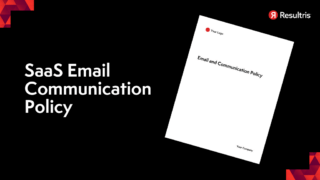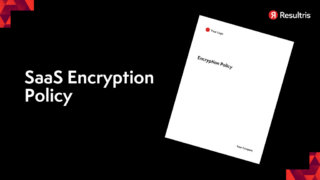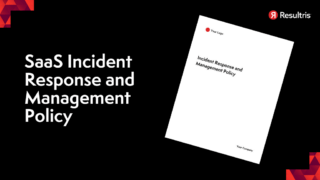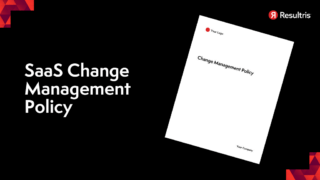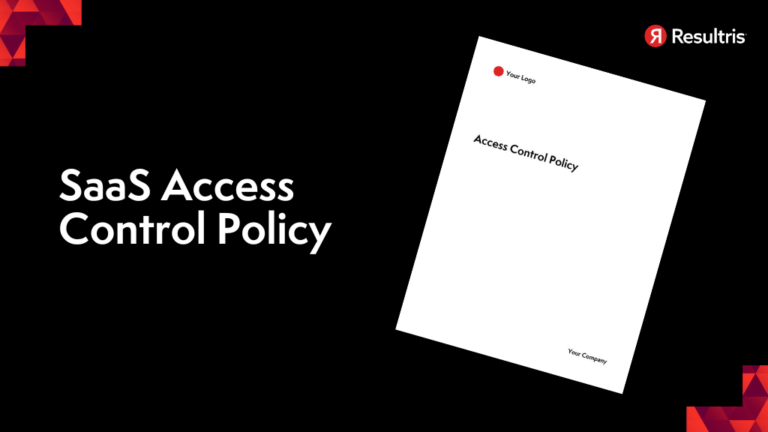
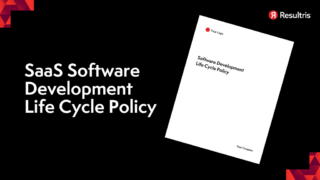
Written by: Tim Eisenhauer
Last updated:

Imagine running a business where you’ve outsourced key functions to Software as a Service (SaaS) providers. It’s efficient, cost-effective, and allows you to focus on what you do best. But have you considered the security implications? How do you ensure that your data, your customers’ data, and your business are safe?
Enter the world of SaaS Access Control Policy. This is the unsung hero in your business’s security arsenal. It’s the gatekeeper that ensures only the right people have access to the right information at the right time.
In this article, we’ll delve into this crucial aspect of SaaS Compliance and Security Best Practices. We’ll discuss the importance of a robust access control policy, explore its key components, and provide insights into how you can implement it effectively in your business. Buckle up, and let’s get started on this journey to secure your SaaS environment.
Understanding the SaaS access control policies becomes critical as you navigate in the digital space of cloud-based technology. Let’s dissect it further.
A SaaS Access Control Policy, by definition, represents the organizational blueprint for dictating who has what kind of access to specific pieces of data within a software application. The primary objective? Prevent data breaches, protect sensitive information, and ensure only the right people access the right resources, and only at the right time. In a nutshell, it’s like a bouncer for your digital club, letting in only the individuals on the list.
Why does it matter for SaaS security? Imagine your software as a vault holding your confidential data. In the wrong hands, this could dismantle your organization’s reputation or worst pose legal issues. Access control policies keep unnecessary hands off the vault, hence pivotal to security in the cloud.
The complexity doesn’t end with implementation—it extends into the realm of regulation. Staying compliant is part of the challenge.
Consider the EU’s General Data Protection Regulation (GDPR). This policy mandates organizations to protect EU citizens’ personal data and dictate stricter penalties for those who do not comply. In essence, a robust Access Control Policy isn’t just a security measure—it’s a compliance necessity.
Moving forward, let’s speak about the industry-specific regulations, for example, the Health Insurance Portability and Accountability Act (HIPAA) for healthcare or SOC 2 for the technology and cloud computing space. These, too, necessitate stringent Access Control Policies, as they aim to safeguard data in their respective fields.
Through the lens of business, it’s clear that SaaS Access Control Policies aren’t just about securing your data—it’s about adhering to the rules of the digital game too. An efficient policy ensures you don’t just stay one step ahead of cyber threats but also helps maintain the much-needed legal equilibrium in the cloud-based business sphere.
A comprehensive SaaS Access Control Policy isn’t crafted overnight. It’s built atop five key components: Identity Management, Authorization and Privileges, Principle of Least Privilege, and Separation of Duties. Let’s unpack these components to grasp their significance better.
Identity Management forms the groundwork of any SaaS Access Control Policy. It’s all about verifying who’s who in your system.
User Authentication Methods range from password systems to multi-factor authentication and biometrics. They provide the good old lock and key to your digital door.
Single Sign-On (SSO) Integration lets users access multiple applications with just one set of login credentials. It’s your express lane at the digital supermarket.
Authorization and Privileges dictate where a user can go and what they can do within your system.
Role-Based Access Control (RBAC) assigns permissions based on the user’s role. Imagine it as a theater, where ushers guide people to seats fitting their tickets.
Attribute-Based Access Control (ABAC) goes a step further, considering variables such as time, location, and task. Compared to RBAC, it’s more akin to a VIP club with a strict dress code and guest list.
The Principle of Least Privilege suggests providing the bare minimum permissions necessary for a user to perform their job. It’s like giving them a tool belt containing only the specific tools needed for a task.
Separation of Duties ensures that key tasks aren’t handled by a single individual. Like a relay race where no one person runs the entire course, there’s a distribution of duties, enhancing security and reducing risks.
Crafting an access control policy complements your business’s leap into the digital world. It’s like providing a secret handshake to guard your online fort. In this section, let’s break down those important steps to achieve a well-rounded method of access control.
First off, understanding your business’s exact requirements forms the crux of developing a thorough access control policy. Start by identifying your unique data that’s at risk, be it customer records, financial statistics, or proprietary information. Consider the number of users accessing the system and the levels of access they require. Existing processes like onboarding, off-boarding, and role transitions could provide valuable clues. Evaluate previous data breaches, security incidents, or compliance violations, if any, to pave the way for strengthening your policy.
The next stage is the definition phase. Classify users into appropriate roles like administrators, managers, and regular users, based on their responsibilities and the data they need access to. To cite an instance, a finance officer doesn’t require access to software development tools, right? Similarly, a software engineer doesn’t need to delve into payroll information. Pinpoint appropriate access levels for each role, making it easier to audit and manage.
Moving forward, formalizing processes for requesting and approving access is a strategical approach. By using automated approval workflows, you avoid unnecessary manual intervention and reduce the likelihood of human error. For instance, an HR manager can initiate the access request for new employees and seek the IT manager’s approval for the same. Implementing such structured methods ensures accuracy, transparency, and accountability.
Rounding off the process, it’s crucial to reinforce your SaaS Access Control Policy with a robust password policy and multi-factor authentication. Advocate for strong, unique passwords and regular password changes. Collaborate security with convenience by introducing multi-factor authentication protocols, for example, biometric validation, SMS codes, or Hardware tokens to create an additional layer of security. Being proactive rather than reactive with your authentication strategy can help you maintain a tight ship.
Moving from the drawing board to reality, here’s how to bring your SaaS Access Control Policy to life.
Dive right into the technical aspects of policy implementation. Let’s start with introducing the systems that make it all possible.
IAM systems play a pivotal role here, acting as the backbone of your SaaS Access Control Policy’s technical implementation. Such systems centralize the task of managing digital identities, ensuring that the right people have the right access to the right resources. Investing in a robust IAM system boosts your policy’s efficacy by facilitating precise track of who is accessing what, providing an essential audit trail in case of security incidents.
Integrating with directory services like Active Directory or LDAP is another important step. These services consolidate user data, making user management more streamlined and efficient. Integration enables seamless, secure access to various SaaS applications, reinforcing your policy’s security fabric by preventing unauthorized access.
User provisioning and de-provisioning lie at the heart of operationalizing your access control policy. Provisioning involves creating, managing, and removing user accounts as per your policy’s defined roles and rules. De-provisioning, on the other hand, is all about ensuring a clean, secure exit whenever a user’s access is withdrawn. Both processes form the core of the policy lifecycle, maintaining the balance between necessary access and security hygiene.
A critical final touch to implementing your access control policy is setting up an access review and certification process. This procedure functions as an audit mechanism, ensuring all policies are adhered to and user access aligns with the predefined roles and rules. Regularly reviewing access measures, re-certifying user rights, and certifying new access requests helps maintain the integrity of your policy, keeping your SaaS environment safeguarded and compliant. Remember, with great power comes great responsibility. Never let the challenge of keeping your data secure intimidate you. With the right planning, processes, and platforms, it’s achievable. And remember, your SaaS Access Control Policy is not a set-it-and-forget-it safeguard—it requires regular reviews and updates, for a secure, compliant SaaS experience.
The quintessence of a secure SaaS environment, as you might agree, is dependent on the ongoing review and enforcement of your access control policies. Distinct facets involved in this process include logging and monitoring access activities, regular access audits, and automated anomaly detection.
Logging and monitoring access activities provide tactical insights into the SaaS environment. Every login attempt, successful or unsuccessful, goes on record in the form of logs. Tracking these activities grants your teams the ability to review all actions, trace them back to individual users, and spot any unusual patterns.
For instance, in case of a security breach, logs offer a retrospect to the sequence of events that led to the situation, aiding in its rectification. Additionally, it contributes to creating a comprehensive security landscape by recording data such as time spent on modules, response times, and frequency of module usage.
Up next on the security checklist are regular access audits. These audits serve to review user access rights, ensuring they align with their current roles in the organization. Any discrepancies spotted through these audits, such as elevated or unnecessary access, can be quickly corrected.
A physical manifestation can serve as an example here. Consider a high-security vault wherein users need different keys to gain access. These keys represent user access entitlements. Regular audits check if the keys are with their rightful owners and if these owners still require the keys.
Automated anomaly detection is the final pillar in monitoring and auditing access. It eliminates the tedious process of manual scrutiny by utilizing machine learning algorithms to detect deviations from normal behavior or policy violations.
These algorithms function akin to a security guard who learns all the routines of a building’s occupants. They understand normal behaviors and are tuned to be vigilant against any anomalies. If someone makes an unscheduled visit or enters restricted areas, alerts are triggered, assisting you in taking prompt corrective action.
Taken together, these key components of monitoring and auditing access play a crucial role in strengthening your SaaS access control policy, while ensuring its efficiency and reliability.
Operational considerations constitute another vital component of SaaS Access Control Policy. We’ll delve into aspects such as employee training, third-party access and role-based access changes.
Employee Training forms an integral part of robust access control policy. Enhancing knowledge and reinforcing behavioral changes fosters individuals capable of safeguarding vital data. Offering regular training on password protection policies, for example, helps employees understand the importance of robust passwords. Furthermore, simulated phishing attacks can help equip them with strategies to identify and report potential security threats.
SaaS applications often involve third-party integrations. It becomes essential, therefore, to actively manage these entities’ access rights to your digital assets. Regular reviews of third-party access policies ensure appropriate access levels. For instance, when integrating CRM platforms with your data analytics tools, ascertain the minimum necessary data access that enables functional integration yet fortifies the defense against data breaches.
Throughout their employment journey, employees often switch roles, and with this transition comes a change in access needs. Removing previous rights and granting new ones prevent misuse of rights no longer relevant. Suppose a marketing executive transitions to the finance department; the individual no longer requires access to design tools but does need access to financial systems. Addressing this quickly ensures seamless operational continuity and secures proprietary information against accidental or deliberate threats.
To ensure that a SaaS access control policy effectively protects your data and keeps you in compliance with various regulations, you’ve got to delve deeper into the technical side of things. This section covers the technical aspects of access control.
Application Programming Interfaces (APIs) serve as powerful communication channels within your SaaS environment. They enable interactions between different software programs. Managing how these APIs access and share data is a crucial part of your access control policy.
It’s important to establish protocols that govern how APIs interact with your data. Firstly, authentication protocols ensure only approved APIs have access, often achieved using tokens or keys. Examples include OAuth or JWT tokens. Secondly, the authorization process decides the level of access that authenticated APIs receive.
Risks emerge if outsiders breach API security, leading to potential data misuse. To counter such threats, monitor API activities closely. API management tools, such as Apigee or Postman, enable this kind of inspection, detecting and alerting you of any suspicious activities.
Microservices and containerization introduce increased granularity to access control. For instance, Docker and Kubernetes, widely used containerization tools, come with robust in-built features that allow for precise access control.
Microservices-based applications are broken down into small and independent services. These are deployed inside containers, making it possible to limit what each service can and cannot do effectively. For example, Service A may only have read permissions on Database B.
When implemented correctly, this segregation helps in reducing the attack surface area. If an attacker hijacks a microservice or container, the damage they can inflict is limited to that specific service or container.
Managing access to your cloud infrastructure is another critical aspect to consider. Every major cloud service provider, be it AWS, Azure, or Google Cloud, provides sophisticated tools to monitor and control access to your cloud resources.
These tools allow you to grant granular permissions. For instance, you can restrict a user to only upload files to a specific bucket in your S3 storage (in AWS). Similarly, you can allow another user to only start or stop virtual machines in your Compute Engine (in Google Cloud).
Leveraging these features can significantly enhance the security of your SaaS applications. Regularly review and update access rights as your team evolves and your requirements change over time.
Devising a robust SaaS Access Control policy does not come without hitches. You’re likely to encounter a series of challenges, converging from different angles, as you strive to consistently balance access privileges and data security.
In the quest for bullet-proof security, it’s easy to forget about the user. Nonetheless, imposing airtight access control restrictions can adversely affect the user experience, causing productivity dips. For example, multifactor authentication significantly fortifies account security, however, it might slow users down and disrupt their workflow.
Rendering access control inconspicuous and seamless is crucial. Striking a balance entails designing user-friendly authentication processes that do not sacrifice security standards. Efforts aim towards enhancing security while minimizing interruptions to user functions.
In a multi-tenant SaaS setup, a single instance of the application serves multiple clients or “tenants.” Each tenant must have separate, secure access to their shared resources. As each tenant’s access level differs depending on their role and responsibilities, managing access in such an environment turns complex.
Misconfigurations can lead to unauthorized access, thereby breaching data privacy. To avoid this, you need a comprehensive multi-tenant access policy. It ensures specific access rights are assigned based on each tenant’s role, thereby safeguarding sensitive data.
Your SaaS offering might start small, but with growth in your client base and expansion of services, the number of users seeking access to various resources multiplies. As user numbers surge, managing access rights can become a herculean task.
Scalability is key, particularly for access controls. A growing organization needs an access control system that expands with it, accommodating new users without jeopardizing security. Regularly reviewing and updating access rights, even during growth spurts, remains essential to maintaining a robust access control policy. With scalable solutions, organizations can manage increasing data volumes, users, and security requirements effectively.
After delving into the value of SaaS Access Control Policies and identifying key challenges, it’s time to discuss how to optimize these policies. Here’s where best practices come in. You implement these practices to maintain strong security measures while ensuring a smooth user experience.
The Zero Trust Policy is a trusted best practice, but implementing it requires careful planning. A Zero Trust Architecture assumes, in every transaction, that no user or system can be trusted outright. Don’t grant automatic access, even if the request appears to come from a verified source. Verify every access request as if the network were already compromised.
Continuous Authorization and Authentication hold a vital place in the best practices. Unlike the ‘one-time authentication’ scenario, verify user credentials at every checkpoint, consistently. Re-authorization aims to ensure that granted user privileges still hold relevance in relation to the tasks or resources they’re accessing.
And last but never least, you can’t ignore the importance of regular policy reviews. Access permissions should mirror the real-time access needs of each user. Any changes in an employee’s role, for instance, may necessitate the adjustment of their access rights. Regular updates ensure that your access control policy stays current, minimizes security vulnerabilities, and ensures compliance.
Effectiveness of a SaaS Access Control Policy hinges on careful measurement and continuous improvement. Key indicators of success can dictate the state of security and satisfaction among users.
KPIs provide quantifiable measures of access control effectiveness.
Monitoring security incidents connects directly to access control policies.
User satisfaction also plays a significant role in measuring access control effectiveness.
By measuring these metrics, you’re not just evaluating your access control effectiveness; you’re strengthening the security of your system and enhancing user experience.
In the context of enhancing SaaS Access Control Policies, it’s crucial to stay updated with trends that are reshaping the landscape. The ongoing advancements in technology introduce innovative methods that have the potential to revolutionize how access control is implemented and managed.
AI and Machine Learning are transforming the way access management operates. They help analyze a vast amount of user behavior data, primarily those concerning login patterns, location of access, type of access requested, and so on. AI algorithms scrutinize this data for anomalies, flagging suspect instances which could necessitate further investigation. For instance, if a user who typically accesses the system during regular business hours from New York suddenly tries to log in at midnight from Australia, it’s flagged as an anomaly.
Biometric authentication provides an added layer of security in SaaS applications. Fingerprints, iris or retina scans, voice recognition, and facial patterns are becoming increasingly common forms of authentication, especially for applications containing highly sensitive data. These methods not only enhance security but also indirectly empower users by simplifying the login process. Instead of remembering complex passwords, users can now use their unique biological signatures.
You’ve taken a deep dive into the essential components of SaaS access control, best practices, and emerging trends. Now, let’s explore scenarios that require specificity in your SaaS Access Control Policy.
Your customers trust you with their data. It’s crucial to implement appropriate controls to ensure that only authorized personnel access this data, and only for legitimate business purposes. Consider coding restrictive permissions directly into your SaaS platform. It also pays to implement User and Entity Behavior Analytics (UEBA). This sophisticated tool detects anomalies in user behavior, offering a robust line of defense against unauthorized data access.
Dealing with developer and admin access can be a tightrope walk. On one hand, these roles might require broad permissions for task execution. On the other hand, these permissions might pose security threats if misused, intentionally or otherwise. It’s beneficial to have clear, well-crafted access policies for developers and admins. Apply the principle of least privilege — grant minimum permissions necessary for duty performance. Also, consider additional safeguards like session recording and automated activity logging.
There might be occasions when temporary or emergency access to your SaaS platform becomes necessary. It could be a developer fixing a critical bug or a temporary project team needing access during their tenure. Tailored temporary access policies can manage this need effectively while minimizing risk. Establish protocols for granting, monitoring, and revoking temporary access. Likewise, emergency access might be necessary in response to incidents or periods of high demand. It is optimized by having clear emergency access procedures in place, allowing immediate response while maintaining security.
Remember, in the world of SaaS Access Control, specificity is a strength. Address these specific scenarios in your policy, and you’ll take one more step towards a robust, secure system.
When it comes to SaaS Access Control Policy, the balancing act between security and productivity remains a tightrope walk for many businesses. In this section, let’s delve into three important strategies that can help you streamline your security approach without sacrificing operational efficiency.
To enhance productivity, optimize access workflows. Regularly update and refine processes, ensuring that the access control mechanisms are not becoming roadblocks to your employees’ efficiency. Automated workflows, for instance, can reduce user interaction with the system, minimize access delays, and increase speed. Utilizing SaaS access control solutions which allow for automation alleviates the burden from security teams and provides more swift and secure access.
Empower your users by implementing self-service access request systems. Instead of security teams manually granting access rights, these systems let individual users request access to resources. If the request matches the pre-set conditions, access is granted automatically, hence, preventing unnecessary delays. According to a 2018 Forrester study, Microsoft Azure AD users reported a 50% reduction in helpdesk calls after implementing self-service password and group management systems.
| Study | Reduction Rate |
|---|---|
| Microsoft Azure AD | 50% |
Incorporating contextual guidelines into your SaaS Access Control Policy boosts security without hindering productivity. Implementing policies such as adaptive access control that are aware of the user’s context (i.e., the user’s location, time of access, device used, etc.) can enhance security measures. For instance, a user trying to gain access outside of business hours might face additional authentication steps, without disrupting regular working hours access.
When it comes to SaaS Access Control Policies, it’s imperative to understand the legal and compliance elements at play. Let’s delve into these significant aspects.
At the core of SaaS Access Control lies a critical responsibility – ensuring data protection and privacy. It’s about implementing robust measures for safeguarding sensitive data and confidential information. For instance, encrypted communications protect data in transit, whereas effective data storage strategies like database encryption secure data at rest. A clear-cut access control policy, complemented by advanced technology, performs an imperative role in achieving these goals.
Access policies play a crucial role in demonstrating compliance. Proper allocation of roles, systematic recordkeeping of access logs, and stringent compliance checks all contribute to this aspect. For example, Imposing a minimum privilege rule, where users are granted only those privileges essential for their job, helps businesses adhere to privacy regulations like GDPR. Hence, a demonstrably compliant SaaS Access Control policy can act as a safeguard in the regulatory landscape.
Cross-Border data access regulations represent another dimension of compliance. Depending on the geographical regions, different norms apply for data transfer and storage. For instance, Europe’s GDPR has stringent rules for data transfer outside the EU, while the United States’ CLOUD Act regulates cross border data requests by law enforcement. Hence, it’s crucial to consider these regulations while setting up SaaS Access Control policies. Tailoring them to meet regional statutes ensures legality and provides a robust framework for global operations.
Embarking on crisis management in SaaS environments, access control overwhelmingly assumes center stage. This section examines access control perspectives during security incidents, disaster recovery strategies, and adjustments to implement post-incident.
Reacting to security incidents, managing access rights becomes crucial. Immediate reactions involve isolating affected areas, assessing user access, and evaluating database integrity levels. Categorized as top-priority, these activities limit damage, prevent further intrusions, and boost recovery responses. For instance, re-evaluating access permissions often provides a dual advantage: restraining the attacker’s movements, rendering misappropriation highly challenging for them.
Moving beyond standard measures, a well-structured SaaS Access Control Policy significantly bolsters disaster recovery and business continuity procedures. Two core components constitute this symbiosis – persistent data accessibility and consistent operation continuity. Amid a crisis, for instance, critical employee data accessibility in remote scenarios is pivotal. Similarly, for operation continuity, ensuring admins can seamlessly access control panels, even when primary sites are compromised, is critical.
Once the crisis is mitigated, a candid evaluation of the Access Control Policy is critical. Making post-incident adjustments includes identifying vulnerabilities, rectifying identified gaps, and future-proofing against reoccurrences. For example, after a data breach incident, adjusting access controls may involve revoking unnecessary privileges, initiating more stringent authentication procedures, and perhaps integrating new security measures like biometric verifications. This continuous arsenal upgrade ensures fortified access controls with every learning curve.
User experience, particularly in matters of authentication and access control, plays a crucial role in the success and security of SaaS applications. Let’s delve deeper into how we can make this experience not just secure, but also user-friendly.
Effective access control starts with designing user-friendly authentication methods. Boost security, but not at the cost of usability. Opt for multifactor authentication (MFA) that utilizes different forms of user identification. This could include something the user knows (password), something they have (phone or hardware token), or something they are (biometric data, finger print or facial recognition).
Ensure a seamless login process by offering password recovery methods that are simple and rapid. This could include password reset links sent to the user’s email or a change request implemented from a designated phone number. Making user authentication robust yet friendly increases user adoption, reduces abandonment rates, and encourages compliance.
Next onto communicating access policies to users. Clear, concise, and continuous communication of policies is key to their successful implementation. Users need not be tech-savvy to grasp the importance of following access control directives. Explain policies in non-technical, relevant language.
Take advantage of training sessions, webinars, emails, and internal social media channels to disseminate information. For example, organize monthly policy update newsletters or regular Q&A sessions addressing common user questions. By effectively communicating access policies, users can properly interact with SaaS applications, minimizing the risk of access control breaches.
Lastly, address access-related user support. User issues and emergencies crop up, demanding swift and effective assistance. Allocate sufficient resources to user support to aid in troubleshooting access issues.
Develop a responsive support structure that includes quick support ticket response, 24/7 support availability, and multichannel support through email, phone, and chat. Mitigate users’ access frustrations promptly to maintain their productivity and prevent negative impact on their SaaS experience.
The practice of solid user support gives users the confidence to embrace your SaaS platform fully, knowing they can count on quick, reliable help when running into access control issues. And remember, your access control policies are only as strong as your weakest user – so educating, supporting, and facilitating access control for users is paramount to your SaaS security.
Effectively integrating SaaS access control with your overall security strategy is vital for maintaining consistency and efficiency. Integrate a holistic view of security, tying access control into data classification policies, incident response plans, and other security measures like encryption.
When defining access controls, alignment with data classification policies is key. Consideration of classified data types such as ‘Public’, ‘Internal’, ‘Confidential’, and ‘Restricted’ guides access provision. For example, ‘Public’ data, like press releases, can be accessed by anyone. In contrast, ‘Restricted’ data, such as financial reports, is reserved only for selected individuals. A well-aligned classification policy ensures each user gets the appropriate level of data access, reinforcing both data privacy and security.
Another essential integration component is your incident response plan. If an access control breach occurs, your response plan instantly determines the steps taken. It guarantees faster resolution, minimal data damage, and quick system recovery. Your incident response plan should outline roles, responsibilities, communication channels, and action steps following an event like unauthorized data access or user account exploitation.
Don’t forget your other security policies. Encryption, for example, enhances access control. It protects data from unauthorized access even if it ends up in the wrong hands. Likewise, other policies such as intrusion detection, antivirus management, or firewalls work harmoniously with access controls. By integrating these policies together, you create a strong, coherent, and comprehensive security strategy.
You’ve now navigated the intricate world of SaaS Access Control Policies, understanding their pivotal role in data security and regulatory compliance. You’ve explored the core components, technical implementation, and best practices that ensure a robust security framework. You’ve also looked into the future, with AI, Machine Learning, and Biometric Authentication leading the way in access control. You’ve seen how specific scenarios require tailored policies and realized the importance of user-friendly authentication methods. The need for clear communication and efficient user support can’t be overstated. You’re now aware that integrating these policies into your overall security strategy is essential. You’ve seen how they align with data classification, incident response, and other security measures, creating a comprehensive safety net for your SaaS applications. Remember, a well-implemented SaaS Access Control Policy isn’t just a digital bouncer—it’s the foundation of your application’s security.
Disclaimer
Please note that the information provided in this blog post is for informational purposes only and does not constitute legal advice. We are not lawyers, and reading this content does not create an attorney-client relationship. For legal advice specific to your situation, please consult with a qualified attorney.

